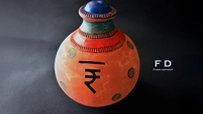Analysing the Historical Performance of Recurring Deposit Rates
December 09, 2024

Whether you are a conservative investor looking for a safe savings option or someone wanting to build a corpus through regular contributions, Recurring Deposits (RDs) have long been a popular choice in India. RDs offer a predictable return on investment while ensuring the safety of your hard-earned money. But have you ever wondered how RD rates have performed historically? In this blog, we will delve into the historical recurring deposit performance, analysing key interest rate trends and their impact on long-term returns in India.
Let's explore the journey of RD rates over time and understand how economic factors have influenced them.
Historical Recurring Deposit Performance in India
Pre-1990s: RDs as a Traditional Savings Vehicle
Before India's economic liberalization in the 1990s, RDs were primarily a mean to safeguard wealth rather than actively grow it. During this period, interest rates for RDs remained stable but low, typically around 4-6%. The Indian economy was growing at a slower pace, and there was a limited demand for high-interest returns.
Post-1991 Liberalisation: Higher RD Rates and Economic Reforms
The economic reforms of 1991 brought significant changes to India's financial sector, including banking reforms. With the opening up of the economy and increased competition among banks, recurring deposit rates started to climb. Interest rates during the mid-1990s saw an increase, with RD rates sometimes touching 9-10% annually. This was reflective of the high inflation and elevated interest rate environment that persisted as India adjusted to its new economic reality.
However, this period also witnessed volatility in interest rates. As inflation fluctuated, the Reserve Bank of India (RBI) intervened to stabilise the economy by adjusting repo rates, which in turn affected recurring deposit rates.
Early 2000s: Stabilisation and Moderate Rates
As India entered the new millennium, the economy began stabilising, and inflation was brought under control. Recurring deposit rates followed the broader trend of falling interest rates in the early 2000s. Rates ranged between 5-7%, offering steady, moderate returns. Investors increasingly looked at RDs as part of a balanced portfolio that included stocks and other investment vehicles. While the rate of return wasn’t spectacular, RDs still provided a reliable and risk-free saving option, especially for those with short-term goals.
Global Financial Crisis (2008): RD Rates Drop Sharply
The global financial crisis of 2008 had a significant impact on interest rate trends in India. In response to the economic downturn, the RBI slashed key interest rates to spur growth and maintain liquidity in the financial system. Consequently, recurring deposit rates also witnessed a drop, going as low as 4-5%. This was a tough period for conservative investors relying on fixed-income investments, as overall returns on RDs and other fixed deposits were severely impacted.
Post-2010: Interest Rate Volatility and RBI Interventions
After the 2008 financial crisis, the Indian economy recovered but faced new challenges, such as inflationary pressures and global economic uncertainties. The RBI adjusted its monetary policy several times during this period, leading to fluctuations in RD interest rates.
Between 2010 and 2014, recurring deposit rates hovered between 7-9%. The elevated inflation rates during this period led the RBI to hike interest rates, making RDs once again attractive to savers. However, starting in 2015, with inflation under control and the RBI taking a more dovish stance, RD rates began to decline, falling to the 6-7% range.
2020-Present: COVID-19 Pandemic Hits RD Rates
The COVID-19 pandemic in 2020 further disrupted financial markets worldwide. As the RBI focused on protecting the economy from the severe impacts of the pandemic, interest rates were cut to historic lows. Recurring deposit rates during this period dropped significantly, falling below 5% in many cases. With low inflation and weak economic growth, banks had little incentive to offer higher interest rates.
Despite these challenges, as the economy started to recover towards the end of 2021, RD rates slowly began to improve, which continues to date.
Key Factors Influencing RD Interest Rate Trends
- Inflation: Higher inflation typically leads to higher interest rates as the central bank attempts to curb spending and borrowing. Conversely, low inflation periods often see lower interest rates.
- RBI Policy: The RBI's monetary policy, particularly its adjustments to the repo rate, directly influences the interest rates offered on RDs by banks.
- Global Economic Trends: External factors, such as global financial crises or pandemics, can lead to sharp interest rate adjustments, as seen in 2008 and 2020.
- Bank-Specific Policies: Individual banks may offer varying RD rates depending on their liquidity needs and customer base.
Long-Term Analysis of Recurring Deposit Rates
Analysing the historical performance of recurring deposit rates reveals a dynamic relationship between economic cycles, inflation, and central bank policies. While RD rates have experienced periods of highs and lows, they have remained a trusted savings tool for conservative investors. Over the long term, RD rates have ranged from as low as 4% during economic downturns to as high as 10% in periods of inflationary pressure. However, the average rate over the last 30 years has remained between 6-7%, making RDs a dependable option for risk-averse investors.
For investors looking at long-term financial planning, RDs can be part of a diversified portfolio, especially when interest rates are on an upward trajectory. While they may not offer the highest returns compared to instruments like equities or mutual funds, RDs provide the security of guaranteed returns and capital preservation.
Final Thoughts
Despite fluctuations, RDs have consistently offered a safe and reliable option for Indians. By understanding the long-term trends and factors influencing RD rates, you can make more informed decisions about incorporating them into your financial strategies.
Start small, dream big! Invest in Ujjivan Small Finance Bank’s Recurring Deposit and enjoy higher interest rates! Save for your long- and short-term goals with our RD and live a stress-free financial life. Start investing with just ₹100!
Disclaimer:
The contents herein are only for informational purposes and generic in nature. The content does not amount to an offer, invitation or solicitation of any kind to buy or sell, and are not intended to create any legal rights or obligations. This information is subject to updation, completion, amendment and verification without notice. The contents herein are also subject to other product-specific terms and conditions, as well as any applicable third-party terms and conditions, for which Ujjivan Small Finance Bank assumes no responsibility or liability.
Nothing contained herein is intended to constitute financial, investment, legal, tax, or any other professional advice or opinion. Please obtain professional advice before making investment or any other decisions. Any investment decisions that may be made by the you shall be at your own sole discretion, independent analysis and evaluation of the risks involved. The use of any information set out in this document is entirely at the user’s own risk. Ujjivan Small Finance Bank Limited makes no representation or warranty, express or implied, as to the accuracy and completeness for any information herein. The Bank disclaims any and all liability for any loss or damage (direct, indirect, consequential, or otherwise) incurred by you due to use of or due to investment, product application decisions made by you on the basis of the contents herein. While the information is prepared in good faith from sources deemed reliable (including public sources), the Bank disclaims any liability with respect to accuracy of information or any error or omission or any loss or damage incurred by anyone in reliance on the contents herein, in any manner whatsoever.
To know more about Ujjivan Small Finance Bank Products Visit:"https://www.ujjivansfb.in"
All intellectual property rights, including copyrights, trademarks, and other proprietary rights, pertaining to the content and materials displayed herein, belong
to Ujjivan Small Finance Bank Limited or its licensors. Unauthorised use or misuse of any intellectual property, or other content displayed herein is strictly prohibited and the same is not intended for distribution to, or use by, any person in any jurisdiction where such distribution or use would (by reason of that person’s nationality, residence or otherwise) be contrary to law or registration or would subject Ujjivan Small Finance Bank Limited or its affiliates to any licensing or registration requirements.
FAQs
1. How do I calculate the maturity amount of a recurring deposit?
To calculate the maturity amount, use the formula A = P(1+r/n) ^ nt, where 'A' represents final amount procured, 'P' represents principal, 'r' represents annual interest rate, 'n' represents the number of times that interest has been compounded, 't' represents the tenure. However, manual calculations can be taxing. Instead, use our Recurring Deposit calculator.
2. Are recurring deposits taxable?
Yes, the interest earned on recurring deposits is taxable as per your income tax slab. A TDS of 10% is applicable if the interest income increases ₹40,000 (₹50,000 for senior citizens) in a financial year.
3. Can I withdraw my money from a recurring deposit anytime?
No, you cannot withdraw your money from an RD before its maturity date. Premature withdrawals may attract penalties or reduced interest rates.
4. What happens if I miss an installment in my recurring deposit?
Missing an installment in your RD can lead to penalties or a reduced interest rate. It is essential to make regular contributions to maximise your returns. Ujjivan doesn’t charge any RD premature withdrawal fee provided the account is foreclosed after 6 months from the time of deposit.
5. Can I take a loan against my recurring deposit?
Yes, many banks offer loans against recurring deposits as collateral. The loan amount is typically a percentage of the RD balance.
6. Are RDs suitable for long-term financial goals?
RDs are suitable for short to medium-term financial goals. For long-term goals, you may consider other investment options that offer higher returns like Fixed Deposits.
Latest Blogs

ITR-1 (Sahaj) Restrictions: Income Sources Not Allowed & Filing Rules
With just a few days left before the 15 September 2025 deadline for filing Income Tax Returns (ITRs) for Assessment Year (AY) 2025-26, many taxpayers are rushing to submit their forms online.

GST Rate Cut on Electronics: What It Means for Consumers and Retailers
India’s Goods and Services Tax (GST) system has entered a new era with the rollout of GST 2.0, effective from September 22, 2025.

Banking Safety Guide: How to Avoid QR Code Frauds While Making Payments
India’s love for QR code payments has made transactions lightning-fast, but also opened a new front for cybercriminals.

Scam Alert! Phishing, Vishing, and Smishing Can Drain Out Your Finances
Digital banking in India has transformed the way we manage money.

India’s New GST Reform Bill: What GST 2.0 Means for You
India’s indirect tax system is entering a landmark new phase.





